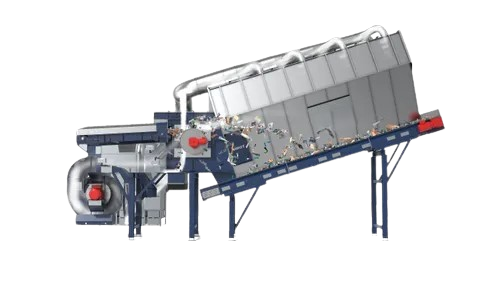Magnetic Separator
A magnetic separator is an essential device in various industries for separating magnetic materials from non-magnetic materials. It uses magnetic forces to attract and remove ferrous contaminants or to isolate valuable magnetic materials. Magnetic separators are widely used in recycling, mining, food processing, and manufacturing to ensure product purity and process efficiency.
Components
- Magnetic Drum or Roll
- Material: Typically made of high-strength magnets, such as rare-earth magnets, and a drum or roll made from steel or aluminum.
- Design: The drum rotates to move material through a magnetic field, attracting magnetic particles.
- Magnetic Pulley
- Material: Made of powerful permanent magnets or electromagnets.
- Design: Installed at the end of a conveyor belt, it attracts magnetic materials as the belt moves over it.
- Magnetic Plate or Grid
- Material: Composed of magnetic bars or plates, often using rare-earth magnets.
- Design: Installed in chutes or hoppers to catch ferrous contaminants as material flows over or through it.
- Magnetic Separator Housing
- Material: Constructed from steel or high-strength plastic.
- Design: Encloses the magnetic components and provides structural support.
- Control System
- Control Panel: Allows operators to manage the separator’s operation, including turning it on or off and adjusting settings.
- Sensors: Detect the presence of magnetic materials and provide feedback for automated control.
- Discharge Chute
- Material: Usually made from metal or high-impact plastic.
- Design: Directs the separated magnetic and non-magnetic materials to different collection points.
- Cleaning Mechanism
- Type: Manual or automated systems to remove collected magnetic materials from the separator.
- Design: Includes brushes, wipers, or pneumatic systems.
Working Principle
- Material Flow: Material is fed onto or through the magnetic separator, such as a conveyor belt or vibrating feeder.
- Magnetic Field Generation: Magnetic components generate a magnetic field that attracts ferrous or magnetic materials.
- Separation: Magnetic materials are attracted to the magnetic drum, pulley, or grid and are separated from the non-magnetic materials.
- Discharge: Separated magnetic materials are collected and removed from the separator, while non-magnetic materials continue through the system.
Types of Magnetic Separators
- Magnetic Drum Separator
- Description: Uses a rotating drum to separate magnetic materials from non-magnetic ones.
- Application: Often used in recycling and mining for bulk material processing.
- Magnetic Pulley Separator
- Description: A magnetic pulley installed at the end of a conveyor belt attracts magnetic materials as the belt moves over it.
- Application: Suitable for continuous, high-volume separation in bulk material handling.
- Magnetic Plate Separator
- Description: Magnetic plates or grids installed in chutes or hoppers to capture ferrous contaminants.
- Application: Commonly used in food processing and manufacturing to ensure product purity.
- Overband Magnetic Separator
- Description: Installed above a conveyor belt, it captures magnetic materials that pass underneath.
- Application: Used in recycling and bulk handling to remove ferrous contaminants from material streams.
- Magnetic Drawer Separator
- Description: Consists of multiple rows of magnetic bars that can be pulled out for cleaning.
- Application: Ideal for processing powders and granules in the food and pharmaceutical industries.
- Electromagnetic Separator
- Description: Uses electromagnets to generate a magnetic field, which can be adjusted in strength.
- Application: Suitable for applications requiring adjustable magnetic force and higher separation efficiency.
Applications
- Recycling: Removing ferrous contaminants from recyclable materials such as paper, plastics, and metals.
- Mining: Separating valuable magnetic ores from waste rock.
- Food Processing: Ensuring product purity by removing ferrous contaminants from food products.
- Manufacturing: Protecting equipment by removing metal contaminants from raw materials.
- Pharmaceuticals: Ensuring the purity of pharmaceutical powders and granules.
Benefits
- Efficiency: Provides effective separation of magnetic materials, improving product quality and process efficiency.
- Versatility: Suitable for a wide range of materials and industries.
- Maintenance: Low maintenance compared to other separation methods.
- Product Purity: Improves product quality by removing contaminants and preventing equipment damage.
- Cost-Effective: Reduces costs associated with equipment damage and product waste.
Design Considerations
- Material Type: Choose a magnetic separator designed to handle the specific type of material being processed, including its size, weight, and magnetic properties.
- Capacity: Ensure the separator is sized to handle the volume of material being processed.
- Magnetic Strength: Select the appropriate magnetic strength for the required separation efficiency.
- Environmental Conditions: Consider factors such as temperature, humidity, and exposure to chemicals when selecting materials and designing the system.
- Safety Features: Incorporate safety guards, emergency stop mechanisms, and other safety features to protect operators and equipment.
Typical Layouts
- Straight Flow: Material flows directly through the magnetic separator in a straight line.
- Curved Flow: Material is directed around curves or obstacles within the separator.
- Inclined Flow: Magnetic separator is angled to facilitate material flow from a higher to a lower elevation.


